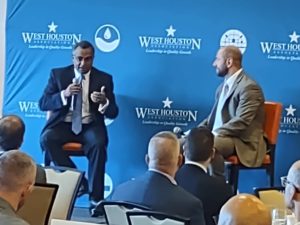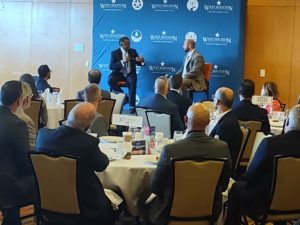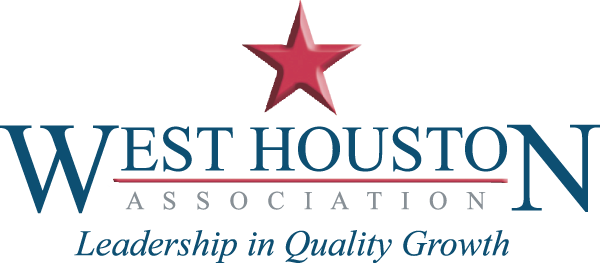On July 14th the West Houston Association hosted a sold-out forum which focused on a discussion between METRO Chair Sanjay Ramabhadran and WHA Regional Mobility Committee Chair Jim Webb (The Goodman Corporation) regarding the question, “What is the Future of Mass Transit in West Houston?”
Jim Webb took the wheel by asking about the Boost Network Corridor, which will span from the Energy Corridor down Highway 6 and connecting to Westheimer. Ramabhadran responded by highlighting the importance of this corridor and that it signifies that the West Houston region is booming.
Why is it booming? It begins with a 53-mile ship channel, two airports, a space port, and a wide variety of industries. Houston is a gateway for people, goods, services, and above all, innovation. West Houston is a corridor not just to the rest of the state, but to the rest of the U.S., as well. Transportation through this corridor is a multibillion-dollar industry, and reliable transportation systems for both people and supply-chain are paramount. Projects such as the University Corridor that connects east Houston to west Houston will drive the local economy for generations to come.
METRONext intends to invest $7.5 billion over the next 20 years to focus on 500+ miles of improvements to regional mobility to improve quality of life for all Houstonians.
 What improvements is METRO looking to address specifically? The University Corridor will be the longest Bus Rapid Transit line in the U.S. With jobs centering around any one of at least three Central Business Districts in Houston, the connection the University Corridor line will offer throughout Houston is a priority, now. Post pandemic, there is a resurging need for workforce transportation and creative, sustainable solutions. Park and rides, for example, are being reimagined with multifunctional design and public-private partnerships in mind. METRO has seen commuter ridership return on primarily Tuesdays through Thursdays, and they continue to monitor for increased density of ridership at the same time they have increased their crime prevention measures throughout all their routes. Infrastructure is never far from METROs vision for the future, either.
What improvements is METRO looking to address specifically? The University Corridor will be the longest Bus Rapid Transit line in the U.S. With jobs centering around any one of at least three Central Business Districts in Houston, the connection the University Corridor line will offer throughout Houston is a priority, now. Post pandemic, there is a resurging need for workforce transportation and creative, sustainable solutions. Park and rides, for example, are being reimagined with multifunctional design and public-private partnerships in mind. METRO has seen commuter ridership return on primarily Tuesdays through Thursdays, and they continue to monitor for increased density of ridership at the same time they have increased their crime prevention measures throughout all their routes. Infrastructure is never far from METROs vision for the future, either.
Universal Accessibility is a cornerstone standard for improvements to shelters, sidewalk connectors within a quarter mile of bus stops, and workforce housing. METRO is willing to commit base amounts of funding for these projects to bring these visions into reality with community partners, developers, and management districts among others.
Among other issues that were discussed are the idea of a ‘mobility TIRZ’ whereby tax dollars could be kept locally to invest in mobility projects, and seeing more retail development at Park & Rides such that you could buy a cup of coffee while waiting for a bus. Both of these ideas are further out on the horizon, but could be unique ways to provide quality of life enhancements in regards to regional mobility.

Ramabhadran closed by acknowledging WHA as a long-time community partner in visioning public transportation for West Houston. Specifically, he discussed the Gessner BRT and the plan to move the Boost to Beltway 8, a move successfully advocated for by WHA Regional Mobility committee members in 2019. Such a move will take the route where the ridership and businesses are and working with Harris County Toll Road Authority to maximize already existing investments.
“Visionary regional transportation planning requires time and community education, and METRO is excited to partner with organizations such as WHA to offer feedback about what the community wants, convene conversations about innovation and funding, and create workable solutions.” As quoted by Ramabhadran, “Those who plant trees, knowing that only others will enjoy the shade, are public benefactors.”
